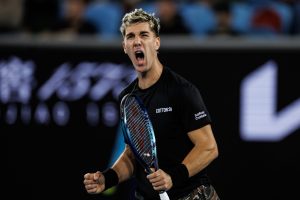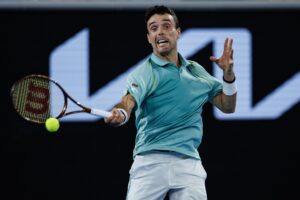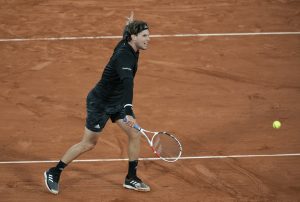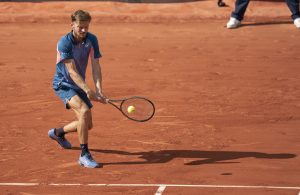When I read this week that Johanna Konta was still competing in China, I assumed that, having forgotten to put my clocks back last weekend (to readjust them to British Standard Time), I had somehow slipped back several weeks in time. That was when Konta was competing in the China Open in Beijing and the Hong Kong Open in a desperate attempt to try and qualify for the WTA Finals in Singapore. Instead, when I cleared my head from the fog of time, I realised that she was actually in Zhuhai competing in the WTA Elite Trophy.
The WTA Elite trophy may be the most misleadingly titled tennis tournament there is. Indeed, it may be the most misleadingly titled sporting event full-stop. That is because it does not feature “the WTA Elite” at all. They were all in Singapore last week, including Svetlana Kuznetsova, who narrowly pipped Konta to the final qualifying place. Instead, the WTA Elite Trophy features the next best women players in the world, the leading 12 players who did not qualify for the WTA Finals. They are organised into four groups of three, with the winner of each group reaching the semi-finals this weekend.
Konta made a great start to the tournament by defeating Sam Stosur, a former US Open winner, in straight sets. The victory proved that she is entirely deserving of the title of 2016 WTA Most Improved Player of The Year, which she won last month. Beating the Australian Stosur may even have evoked memories of Konta’s breakthrough tournament at the beginning of the year, when she reached the semi-finals of the Australian Open before losing to the eventual winner, Angelique Kerber (for whom it was an even bigger breakthrough tournament, as it gave her a first Major title).
Konta consolidated on her performance in Melbourne throughout 2016, including winning her first WTA title at Stanford in June, beating the great and fêted Venus Williams in three sets in the final. By the end of the year, she was the first British woman (albeit one who was born in Australia to Hungarian parents) to win a place in the world’s top 10 since Jo Durie more than thirty years ago. That was a fitting tribute to Konta’s tireless pursuit of self-improvement this year. The only thing that would have capped the year off in even more spectacular style was a place at the WTA Finals.
Why the real elite are not at the WTA Elite Trophy
It would be fascinating to know what Konta and the other women from the world’s top 20 who are competing in Zhuhai really think of the tournament. There can certainly be no doubt that they would much rather have been in Singapore last week, with the real elite, than in Zhuhai this week, with the “not quite elite”.
The WTA website proudly declares that “tennis is booming in Asia” and that the WTA Elite Trophy is “the 13th tournament in the region”. While the first statement is undeniably true, one wonders what good the presence of a “13th tournament in the region” will really do for the promotion of the game in Asia. The very fact that it is the women who were not quite good enough to reach Singapore, including Konta, who are competing in Zuhai inevitably gives it the feeling of a second-rate, or “sub-elite”, tournament.
What is perhaps most striking about the WTA Elite Trophy (other than its title) is its scheduling. If the WTA feels that there is a genuine need for a tournament featuring the players who didn’t make it to the WTA Finals, surely it makes sense to have it before the WTA Finals, rather than immediately after. Its current scheduling means that it inevitably has an air of “after the Lord Mayor’s show” and in effect seems little more than an exhibition event, even if the $2 million-plus prize money is far in excess of what would normally be on offer at an exhibition event.
Of course, in one sense none of this really matters, because if the WTA, the event itself and its sponsors are happy to shoehorn in one more tournament before the end of the season and the Fed Cup final, that is their prerogative. On the other hand, it might be part of a wider movement by traditionally Western-dominated sports such as tennis to market themselves in China but without really giving the Chinese audience the premier product that it craves and surely deserves.
Not just a problem in tennis?
This has been evident in other sports, notably football. In January of this year, clubs in the Chinese Super League ended up spending more money on transfers, mainly of foreign players, than clubs in the English Premier League did. However, it is questionable how much value for money, or more precisely how much genuine “star power”, the Chinese clubs secured for the outlandish fees that they paid.
The majority of the biggest imports were, by the standards of the top European leagues, either unwanted or decidedly second-rate. Among them were the Colombian striker Jackson Martinez’s £31 million move from Atletico Madrid to Guangzhou Evergrande Taobao and Brazilian playmaker Alex Teixeira’s £38.4 million move from Shakhtar Donetsk to Jiangsu Suning. Arguably only the acquisition of Teixeira’s fellow Brazilian Ramires, also by Jiangsu Suning, from Chelsea for £25 million was the signing of a genuinely highly rated player, one who would merit inclusion in most top European sides. Too many of the others were “stars” in name, and transfer fees, only.
These expensive purchases were supposed to translate into higher attendances in, and a higher world profile for, the Chinese Super League, but it is extremely doubtful that those things have been achieved. Even within China itself, so many of the country’s ordinary football fans choose to watch EPL games on television rather than go to Chinese stadia to see EPL rejects such as Ramires up close and in person.
The January transfer window in football was obviously at the start of the calendar year, but it is possible that we are seeing the same pattern being repeated now, near the end of the year, with the WTA Elite Trophy, which does not feature any of the WTA’s actual elite. The question must be asked whether Chinese tennis fans and Chinese sports fans in general are being well served by these offerings of second-rate players and second-rate tournaments, when, like most true tennis and sports fans, what they really want to see are the very best players and teams.
It is something that Western sports teams and traditional Western sports in general, including tennis, should consider seriously as the “rush for red gold” in China currently continues unabated. There may well come a point in the not-too-distant future where Chinese fans, sponsors and tournaments reject the misrepresentation of events such as the “WTA Elite Trophy” and argue for more meaningful sporting competitions, such as the WTA Finals itself, to be staged in their country.
Main Photo:






